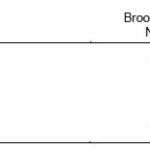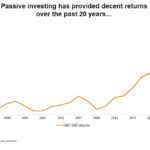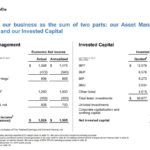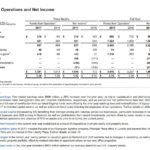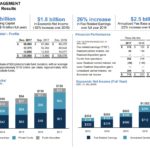Contents
Summary
- BAM has generated a compound annual total return of ~17% (dividends reinvested) since 1997 versus ~7% for the S&P 500.
- Management is cognizant of short-term performance but the business is managed for the long term with a goal to generate 12% – 15% compound returns over the longer term.
- BAM partners with institutional investors and sovereign wealth funds, grows allocations to alternative assets, and its business model is designed to capture value from its investments.
- The executive group owns, directly or indirectly, ~200 million shares, or 20% of the total outstanding shares. This is a strong incentive for the management team to think and act like owners as they create value for shareholders.
Introduction
Brookfield Asset Management (NYSE: BAM) released its Q4 and FY2017 results on February 15, 2018.
While this article provides a high level overview of BAM, you are strongly encouraged to view the September 27, 2017 Investor Day presentation and to read the transcript associated with the presentation. Management provides a comprehensive overview of the business which cannot possibly be covered in this article.
BAM is a leading global alternative asset manager with approximately $285B of assets under management. For more than 100 years it has owned and operated assets on behalf of shareholders and clients with a focus on property, renewable power, infrastructure and private equity.
BAM’s operations are organized into 5 operating business groups. The property, renewable power, infrastructure and private equity business groups are responsible for operating the assets owned by BAM’s various funds and investee companies. The equity capital invested in these assets is provided by a series of listed partnerships and private funds which are managed by BAM and which are funded with capital from BAM and its clients.
A fifth group operates BAM’s asset management business. This group is responsible for managing BAM’s various pools of capital, developing new products for BAM clients, and fundraising for various fund products.
BAM’s balance sheet capital is invested primarily in its four flagship publicly listed partnerships:
- Brookfield Property Partners L.P. (NYSE: BPY);
- Brookfield Renewable Partners L.P. (NYSE: BEP);
- Brookfield Infrastructure Partners L.P. (NYSE: BIP);
- Brookfield Business Partners L.P. (NYSE: BBU).
In addition to owning assets directly, these partnerships serve as the cornerstone in which BAM invests capital committed by institutional investors. BAM has found that its approach and corporate structure enable it to attract a broad range of public and private investment capital. It also provides BAM with the ability to match its various investment strategies with the most appropriate form of capital.
BAM is in an ideal position in that the amount of capital controlled by institutional investors continues to grow. In 2008 there was ~$23 trillion available for investment purposes. This amount has increased to ~$43 trillion in 2016.
Institutional investors are now attracted to real assets and alternative investments. They provide an attractive solution in that:
- this allows them to diversify from traditional investments which have higher valuations;
- values maintain themselves through cycles with less volatility;
- these investments are cash yielding thus providing cash flow.
The result is a continued shift in pension fund allocations to alternative investments. In 2008 there was $3 trillion of US pension assets allocated to alternative investments. This has increased to $9 trillion in 2016.
These allocation trends are expected to continue since in a rising interest rate environment real assets retain their values across cycles. In addition, equities are richly valued so real assets provide diversification.
Source: BAM Investor Day Presentation September 27, 2017
Differentiation
There are other asset managers which compete with BAM. BAM, however, has differentiated itself from its competitors as explained by Bruce Flatt (BAM’s CEO) during BAM’s September 27, 2017 Investor Day presentation.
‘Most of the people that compete with us that are either people like us, managers, other asset managers – they have a different form. We are very active – we own the businesses, we run them, they’re our people. They have some other strategy – they hire guys, they bring it in, etc..
Let’s just say for the point of reference they can do exactly what we do. The difference is they, or we, can buy things, work the assets and get an extra return. Much of the capital that’s out there that invests with us wants to do what we do, but some of them want to do it directly. The difference is they can largely only do things that aren’t operational in nature. We sell them things which are completed and they can earn 5% to 7% returns, or 8% returns, and that’s great for what they’re doing. But we probably bought that asset, re-worked it, released it, re-contracted it, built it, expanded it, and earned ourselves 15% or 20% returns, so the difference is they just can’t do it because they don’t have the people – so the difference is we can buy a toll road on a 6% yield and expand it out the end, and that turns it into a 15% return investment. They just can’t do it.’
In essence, the two most significant advantages BAM has over its rivals are its:
- large scale and global reach;
- operational capabilities.
BAM is structured wherein it can take advantage of opportunities in various areas of the world in which capital is required. As BAM grows in size and scope, the number of companies with sufficient capital to compete diminishes. Furthermore, BAM’s global reach and operational capabilities enables it to bid on out of favor assets.
Historical Returns
BAM investors have been richly rewarded over the years as evidenced by the following.
Source: BAM YF2017 Letter to Shareholders
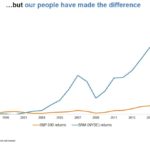 Source: BAM Investor Day Presentation September 27, 2017
Source: BAM Investor Day Presentation September 27, 2017
Terminology
Some readers may be unfamiliar with some of the metrics by which BAM’s performance is measured. I, therefore, provided the following should you need to familiarize yourself with some of the terminology.
Carried Interest
A key measure of BAM’s success is the level of Carried Interest generated. This definition is provided by the Tax Policy Center, Urban Institute and Brookings Institution.
‘Carried interest is a contractual right that entitles the general partner of a private investment fund (often a private equity fund) to share in the fund’s profits. A fund typically uses the carried interest to pass through its net capital gains to the general partner which, in turn, passes the gains on to the investment managers.’
Further information can be found here.
Realized Carried Interest
This represents BAM’s contractual share of investment gains generated within a private fund after considering a client’s minimum return requirements. It is determined on third-party capital that is no longer subject to future investment performance.
Funds From Operating Activities (FFO)
Investors accustomed to using a company’s PE ratio as one of the metrics upon which an investment decision is made should disregard the use of this metric with BAM as it is not meaningful. FFO is the metric which should be used.
FFO is BAM’s share of revenues less direct costs and interest expenses. It excludes realized carried interest and disposition gains, fair value changes, depreciation and amortization and deferred income taxes and it includes BAM’s proportionate share of FFO from operating activities recorded by equity accounted investments on a fully diluted basis.
It also includes realized disposition gains/losses, which are gains or losses arising from transactions during the reporting period, adjusted to include associated fair value changes and revaluation surplus recorded in prior periods, taxes payable or receivable in connection with those transactions, as well as amounts that are recorded directly in equity, such as ownership changes.
Fees earned from managing capital as well as BAM’s share of revenues earned and costs incurred within its operations (includes interest expense and other costs) is also include in the calculation of FFO.
It further includes the impact of contracts into which BAM enters to generate revenue (eg. asset management agreements, power sales agreements and contracts that BAM’s operating businesses enter into such as leases and take or pay contracts, and sales of inventory).
Target Carry
BAM reflects its estimate of the carried interest earned on a straight-line basis over the life of a fund, assuming target returns are achieved.
Q4 and FY2017 Financial Results
I strongly encourage you to read BAM’s February 15, 2018 Earnings Release, Presentation, and Bruce Flatt’s (CEO) February 15, 2018 Letter to Shareholders. While the letter is several pages in length it provides a far better recap of BAM’s performance and future prospects than I could possibly provide.
The following 3 images provide a very high level overview of BAM’s most recently released financial results.
Source: BAM Q4 2017 Supplemental Information Presentation
At BAM’s September 27, 2017 Investor Day, management indicated that it had revised its 5-year financial model to reflect an 18% CAGR (up from 16%) in Fee Related Earnings.
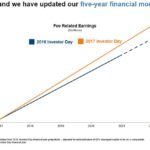 Source: BAM Investor Day Presentation September 27, 2017
Source: BAM Investor Day Presentation September 27, 2017
Credit Ratings
BAM’s long-term credit rating from Moody’s is Baa2 (mid-lower medium grade) and A- (low upper medium grade) from S&P. Both ratings are several notches below the coveted AAA rating but are still deemed investment grade.
Valuation
BAM generated $3.74/share in FFO in FY2017. BAM’s $40.28 closing stock price on February 16, 2018 is ~10.78 times its FFO. This is a fair value for a company with BAM’s growth potential.
BAM’s dividend history can be found here.
BAM’s Board recently declared a quarterly dividend of $0.15/share or $0.60/share/year payable on March 29, 2018 to shareholders of record as at the close of business on February 28, 2018. This represents a 7% increase over the prior year’s $0.56/share annual dividend.
The forward dividend represents a ~1.50% yield on the basis of BAM’s $40.28 closing stock price on February 16, 2018. This forward dividend is only ~16% of BAM’s $3.74/share in FFO generated in FY2017.
This low dividend yield may dissuade some investors from investing in BAM. An investment in BAM, however, should be approached primarily from a capital gains potential perspective. Investors seeking dividend yields would be well advised to look at BAM’s four flagship listed partnerships reflected in the Introduction segment of this article.
Unlike many other companies, BAM repurchases shares but the number repurchased is insignificant relative to the total number of shares outstanding. There were, for example, ~961.3 million shares outstanding at the beginning of FY2016 and 958.2 million shares outstanding as at December 31, 2016. To date, BAM’s management has not viewed the repurchase of BAM shares as the most efficient use of its financial resources.
Final Thoughts
BAM is a highly regarded global alternative asset manager which has generated significant returns for its investors over the years. While BAM is cognizant of short-term performance, the business is managed for the long term; its goal is to generate 12% to 15% compound returns over the longer term.
You should view the increase in the number of sophisticated institutional investors throughout the world willing to invest with BAM as a testament to BAM’s success.
BAM has the expertise to invest in projects which have the potential to generate above average yields over the long-term and the manner in which the BAM conglomerate is structured allows individual investors to share in these above average returns alongside management.
An additional appeal to me is that BAM’s incentive structure is such that BAM’s executive group owns, directly or indirectly, ~200 million shares, or 20% of the total outstanding shares. This is a strong incentive for the management team to think and act like owners as they create value for shareholders.
My original BAM investment was made February 18, 2009 and I still own those shares. I have subsequently added to this initial position over the years. On February 16, 2018 I acquired additional shares for various accounts which are included in, and excluded from, the FFJ Portfolio.
Given management’s long-term approach to its business, I approach my investment in BAM from a similar perspective. My investment in BAM is on the basis of the returns I expect BAM to generate over the next 20+ years. If you decide to invest in BAM, I suggest you follow a similar approach versus approaching your investment from a short-term return perspective.
I hope you enjoyed this post and I wish you much success on your journey to financial freedom.
Thanks for reading!
Note: I sincerely appreciate the time you took to read this article. Please send any feedback, corrections, or questions to charles@financialfreedomisajourney.com
Disclaimer: I have no knowledge of your individual circumstances and am not providing individualized advice or recommendations. I encourage you not to make any investment decision without conducting your own research and due diligence. You should also consult your financial advisor about your specific situation.
Disclosure: I am long TSX: BAM.a.
I wrote this article myself and it expresses my own opinions. I am not receiving compensation for it and have no business relationship with any company whose stock is mentioned in this article.



